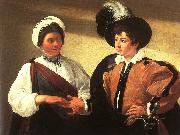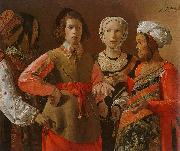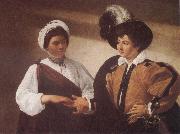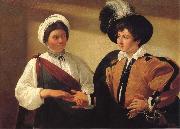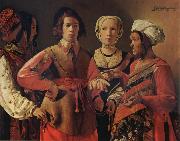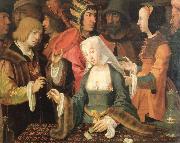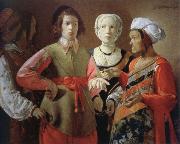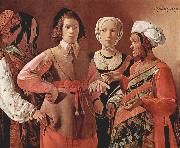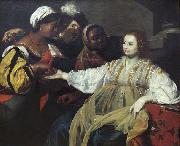Wholesale Oil Painting No Minimum |
|||||||||||
|
|
|||||||||||

|
|||||||||||
|
|
|
||||||||
CaravaggioItalian Baroque Era Painter, ca.1571-1610 Italian painter. After an early career as a painter of portraits, still-life and genre scenes he became the most persuasive religious painter of his time. His bold, naturalistic style, which emphasized the common humanity of the apostles and martyrs, flattered the aspirations of the Counter-Reformation Church, while his vivid chiaroscuro enhanced both three-dimensionality and drama, as well as evoking the mystery of the faith. He followed a militantly realist agenda, rejecting both Mannerism and the classicizing naturalism of his main rival, Annibale Carracci. In the first 30 years of the 17th century his naturalistic ambitions and revolutionary artistic procedures attracted a large following from all over Europe. |
||||||||
|
|
||||||||
The Fortune Teller
The Fortune Teller Painting ID:: 323 |
1594-95
Musee du Louvre, Paris
1594-95 Musee du Louvre, Paris |
|||||||
|
|
||||||||
Georges de La Tour1593-1652 French Georges de La Tour Galleries His early work shows influences from Caravaggio, probably via his Dutch followers, and the genre scenes of cheats??as in The Fortune Teller ??and fighting beggars clearly derive from the Dutch Caravaggisti, and probably also his fellow-Lorrainer, Jacques Bellange. These are believed to date from relatively early in his career. La Tour is best known for the nocturnal light effects which he developed much further than his artistic predecessors had done, and transferred their use in the genre subjects in the paintings of the Dutch Caravaggisti to religious painting in his. Unlike Caravaggio his religious paintings lack dramatic effects. He painted these in a second phase of his style, perhaps beginning in the 1640s, using chiaroscuro, careful geometrical compositions, and very simplified painting of forms. His work moves during his career towards greater simplicity and stillness ?? taking from Caravaggio very different qualities than Jusepe de Ribera and his Tenebrist followers did. He often painted several variations on the same subjects, and his surviving output is relatively small. His son Etienne was his pupil, and distinguishing between their work in versions of La Tour's compositions is difficult. The version of the Education of the Virgin, in the Frick Collection in New York is an example, as the Museum itself admits. Another group of paintings (example left), of great skill but claimed to be different in style to those of de La Tour, have been attributed to an unknown "Hurdy-gurdy Master". All show older male figures (one group in Malibu includes a female), mostly solitary, either beggars or saints. After his death in 1652, La Tour's work was largely forgotten until rediscovered by Hermann Voss, a German scholar, in 1915. In 1935 an exhibition in Paris began the revival in interest among a wider public. In the twentieth century a number of his works were identified once more, and forgers tried to help meet the new demand; many aspects of his œuvre remain controversial among art historians. |
||||||||
|
|
||||||||
The Fortune Teller
The Fortune Teller Painting ID:: 2356 |
1632-35
Metropolitan Museum of Art, New York
102 x 123.5cm / 40.15" x48.62"
1632-35 Metropolitan Museum of Art, New York 102 x 123.5cm / 40.15" x48.62" |
|||||||
|
|
||||||||
PIAZZETTA, Giovanni BattistaItalian Rococo Era Painter, ca.1683-1754 |
||||||||
|
|
||||||||
The Fortune Teller
The Fortune Teller Painting ID:: 19873 |
1740
Oil on canvas
Gallerie dell'Accademia, Venice. 1740 Oil on canvas Gallerie dell'Accademia, Venice. |
|||||||
|
|
||||||||
CaravaggioItalian Baroque Era Painter, ca.1571-1610 Italian painter. After an early career as a painter of portraits, still-life and genre scenes he became the most persuasive religious painter of his time. His bold, naturalistic style, which emphasized the common humanity of the apostles and martyrs, flattered the aspirations of the Counter-Reformation Church, while his vivid chiaroscuro enhanced both three-dimensionality and drama, as well as evoking the mystery of the faith. He followed a militantly realist agenda, rejecting both Mannerism and the classicizing naturalism of his main rival, Annibale Carracci. In the first 30 years of the 17th century his naturalistic ambitions and revolutionary artistic procedures attracted a large following from all over Europe. |
||||||||
|
|
||||||||
The Fortune Teller
The Fortune Teller Painting ID:: 33570 |
mk86
c.1594/95
Oi on canvas
99x131cm
Paris,Musee National du Louvre
mk86 c.1594/95 Oi on canvas 99x131cm Paris,Musee National du Louvre |
|||||||
|
|
||||||||
CaravaggioItalian Baroque Era Painter, ca.1571-1610 Italian painter. After an early career as a painter of portraits, still-life and genre scenes he became the most persuasive religious painter of his time. His bold, naturalistic style, which emphasized the common humanity of the apostles and martyrs, flattered the aspirations of the Counter-Reformation Church, while his vivid chiaroscuro enhanced both three-dimensionality and drama, as well as evoking the mystery of the faith. He followed a militantly realist agenda, rejecting both Mannerism and the classicizing naturalism of his main rival, Annibale Carracci. In the first 30 years of the 17th century his naturalistic ambitions and revolutionary artistic procedures attracted a large following from all over Europe. |
||||||||
|
|
||||||||
The Fortune Teller
The Fortune Teller Painting ID:: 34695 |
mk96
1595
99x131cm
mk96 1595 99x131cm |
|||||||
|
|
||||||||
Georges de La Tour1593-1652 French Georges de La Tour Galleries His early work shows influences from Caravaggio, probably via his Dutch followers, and the genre scenes of cheats??as in The Fortune Teller ??and fighting beggars clearly derive from the Dutch Caravaggisti, and probably also his fellow-Lorrainer, Jacques Bellange. These are believed to date from relatively early in his career. La Tour is best known for the nocturnal light effects which he developed much further than his artistic predecessors had done, and transferred their use in the genre subjects in the paintings of the Dutch Caravaggisti to religious painting in his. Unlike Caravaggio his religious paintings lack dramatic effects. He painted these in a second phase of his style, perhaps beginning in the 1640s, using chiaroscuro, careful geometrical compositions, and very simplified painting of forms. His work moves during his career towards greater simplicity and stillness ?? taking from Caravaggio very different qualities than Jusepe de Ribera and his Tenebrist followers did. He often painted several variations on the same subjects, and his surviving output is relatively small. His son Etienne was his pupil, and distinguishing between their work in versions of La Tour's compositions is difficult. The version of the Education of the Virgin, in the Frick Collection in New York is an example, as the Museum itself admits. Another group of paintings (example left), of great skill but claimed to be different in style to those of de La Tour, have been attributed to an unknown "Hurdy-gurdy Master". All show older male figures (one group in Malibu includes a female), mostly solitary, either beggars or saints. After his death in 1652, La Tour's work was largely forgotten until rediscovered by Hermann Voss, a German scholar, in 1915. In 1935 an exhibition in Paris began the revival in interest among a wider public. In the twentieth century a number of his works were identified once more, and forgers tried to help meet the new demand; many aspects of his œuvre remain controversial among art historians. |
||||||||
|
|
||||||||
The Fortune Teller
The Fortune Teller Painting ID:: 41289 |
mk161
Oil on canvas
mk161 Oil on canvas |
|||||||
|
|
||||||||
Lucas van Leyden1489-1533 Dutch Lucas van Leyden Galleries Lucas van Leyden (Leiden, 1494 ?C August 8, 1533 in Leiden), also named either Lucas Hugensz or Lucas Jacobsz, was a Dutch engraver and painter, born and mainly active in Leiden, who was among the first Dutch exponents of genre painting and is generally regarded as one of the finest engravers in the history of art. He was the pupil of his father, from whose hand no works are known, and of Cornelis Engelbrechtsz, but both of these were painters whereas Lucas himself was principally an engraver. Where he learnt engraving is unknown, but he was highly skilled in that art at a very early age: the earliest known print by him (Mohammed and the Murdered Monk) dates from 1508, when he was perhaps only 14, yet reveals no trace of immaturity in inspiration or technique. Lot and his daughters (ca. 1509)In 1514 he entered the Painters' Guild at Leiden. He seems to have travelled a certain amount, and visits are recorded to Antwerp in 1521, the year of D??rer's Netherlandish journey, and to Middelburg in 1527, when he met Jan Mabuse. An unbroken series of dated engravings makes it possible to follow his career as a print-maker and to date many of his paintings, but no clear pattern of stylistic development emerges. D??rer was the single greatest influence on him, but Lucas was less intellectual in his approach, tending to concentrate on the anecdotal features of the subject and to take delight in caricatures and genre motifs. Carel van Mander characterizes Lucas as a pleasure-loving dilettante, who sometimes worked in bed, but he left a large oeuvre, in spite of his fairly early death, and must have been a prodigious worker. Lucas had a great reputation in his day (Vasari even rated him above D??rer) and is universally regarded as one of the greatest figures in the history of graphic art (he made etchings and woodcuts as well as engravings and was a prolific draughtsman). His status as a painter is less elevated, but he was undoubtedly one of the outstanding Netherlandish painters of his period. He was a pioneer of the Netherlandish genre tradition, as witness his Chess Players (Gemäldegalerie, Berlin) which actually represents a variant game called 'courier' - and his Card Players (National Gallery of Art, Washington), while his celebrated Last Judgement triptych (Lakenhal Museum, Leiden, 1526-27) shows the heights to which he could rise as a religious painter. It eloquently displays his vivid imaginative powers, his marvellous skill as a colourist and his deft and fluid brushwork. |
||||||||
|
|
||||||||
the fortune teller
the fortune teller Painting ID:: 55999 |
mk247
c.1508 to 10,oil on panel,9x12 in,24x30.5 cm,louvre,paris,france mk247 c.1508 to 10,oil on panel,9x12 in,24x30.5 cm,louvre,paris,france |
|||||||
|
|
||||||||
Georges de La Tour1593-1652 French Georges de La Tour Galleries His early work shows influences from Caravaggio, probably via his Dutch followers, and the genre scenes of cheats??as in The Fortune Teller ??and fighting beggars clearly derive from the Dutch Caravaggisti, and probably also his fellow-Lorrainer, Jacques Bellange. These are believed to date from relatively early in his career. La Tour is best known for the nocturnal light effects which he developed much further than his artistic predecessors had done, and transferred their use in the genre subjects in the paintings of the Dutch Caravaggisti to religious painting in his. Unlike Caravaggio his religious paintings lack dramatic effects. He painted these in a second phase of his style, perhaps beginning in the 1640s, using chiaroscuro, careful geometrical compositions, and very simplified painting of forms. His work moves during his career towards greater simplicity and stillness ?? taking from Caravaggio very different qualities than Jusepe de Ribera and his Tenebrist followers did. He often painted several variations on the same subjects, and his surviving output is relatively small. His son Etienne was his pupil, and distinguishing between their work in versions of La Tour's compositions is difficult. The version of the Education of the Virgin, in the Frick Collection in New York is an example, as the Museum itself admits. Another group of paintings (example left), of great skill but claimed to be different in style to those of de La Tour, have been attributed to an unknown "Hurdy-gurdy Master". All show older male figures (one group in Malibu includes a female), mostly solitary, either beggars or saints. After his death in 1652, La Tour's work was largely forgotten until rediscovered by Hermann Voss, a German scholar, in 1915. In 1935 an exhibition in Paris began the revival in interest among a wider public. In the twentieth century a number of his works were identified once more, and forgers tried to help meet the new demand; many aspects of his œuvre remain controversial among art historians. |
||||||||
|
|
||||||||
the fortune teller
the fortune teller Painting ID:: 56062 |
mk247
c.1632 to 35,oil on canvas,40x49 in,102x123.5 cm,metropolitan museum of art,new york,ny,usa mk247 c.1632 to 35,oil on canvas,40x49 in,102x123.5 cm,metropolitan museum of art,new york,ny,usa |
|||||||
|
|
||||||||
Georges de La Tour1593-1652 French Georges de La Tour Galleries His early work shows influences from Caravaggio, probably via his Dutch followers, and the genre scenes of cheats??as in The Fortune Teller ??and fighting beggars clearly derive from the Dutch Caravaggisti, and probably also his fellow-Lorrainer, Jacques Bellange. These are believed to date from relatively early in his career. La Tour is best known for the nocturnal light effects which he developed much further than his artistic predecessors had done, and transferred their use in the genre subjects in the paintings of the Dutch Caravaggisti to religious painting in his. Unlike Caravaggio his religious paintings lack dramatic effects. He painted these in a second phase of his style, perhaps beginning in the 1640s, using chiaroscuro, careful geometrical compositions, and very simplified painting of forms. His work moves during his career towards greater simplicity and stillness ?? taking from Caravaggio very different qualities than Jusepe de Ribera and his Tenebrist followers did. He often painted several variations on the same subjects, and his surviving output is relatively small. His son Etienne was his pupil, and distinguishing between their work in versions of La Tour's compositions is difficult. The version of the Education of the Virgin, in the Frick Collection in New York is an example, as the Museum itself admits. Another group of paintings (example left), of great skill but claimed to be different in style to those of de La Tour, have been attributed to an unknown "Hurdy-gurdy Master". All show older male figures (one group in Malibu includes a female), mostly solitary, either beggars or saints. After his death in 1652, La Tour's work was largely forgotten until rediscovered by Hermann Voss, a German scholar, in 1915. In 1935 an exhibition in Paris began the revival in interest among a wider public. In the twentieth century a number of his works were identified once more, and forgers tried to help meet the new demand; many aspects of his œuvre remain controversial among art historians. |
||||||||
|
|
||||||||
The Fortune Teller
The Fortune Teller Painting ID:: 59536 |
The Fortune Teller
The Fortune Teller |
|||||||
|
|
||||||||
Nicolas RegnierMaubeuge ca 1590-Venice 1667 |
||||||||
|
|
||||||||
The Fortune Teller
The Fortune Teller Painting ID:: 84902 |
Date ca. 1571(1571)
Medium Oil on canvas
Dimensions 127 x 150 cm (50 x 59.1 in)
cjr Date ca. 1571(1571) Medium Oil on canvas Dimensions 127 x 150 cm (50 x 59.1 in) cjr |
|||||||
|
|
||||||||
VALENTIN DE BOULOGNEFrench Baroque Era Painter, ca.1594-1632 |
||||||||
|
|
||||||||
The Fortune Teller
The Fortune Teller Painting ID:: 92048 |
Oil on canvas, 150 x 239 cm
c. 1620
cjr Oil on canvas, 150 x 239 cm c. 1620 cjr |
|||||||
|
|
||||||||
|
VALENTIN DE BOULOGNE French Baroque Era Painter, ca.1594-1632 The Fortune Teller Oil on canvas, 150 x 239 cm c. 1620 cjr |
||||||||
|
|
||||||||
|
Prev Next
|
||||||||
|
|
||||||||
|
Related Paintings to VALENTIN DE BOULOGNE :. |
||||||||
|
|
||||||||
|
CONTACT US |
